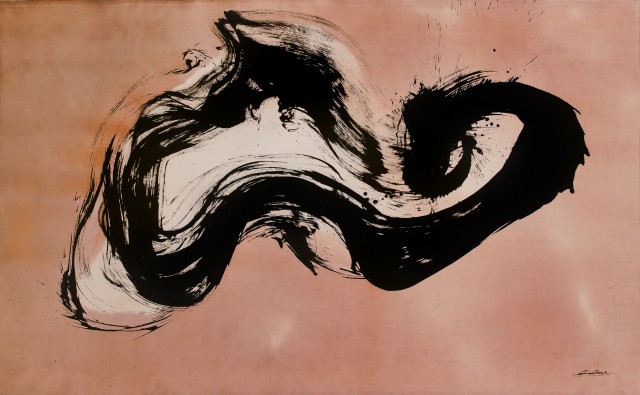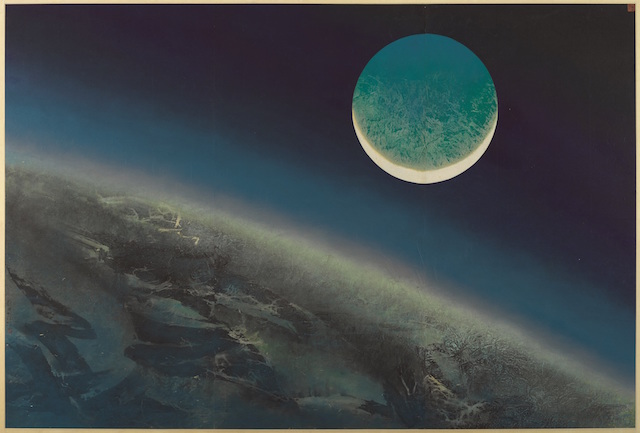The April sales at Sotheby’s Hong Kong marked a coming of age of the market in contemporary Chinese ink painting. At the world’s first single-owner sale in the category, the Swiss-based Origo collection achieved four new artist records, including the top lot of the sale: Liu Dan’s monumental ink on paper of 2008, Poppy (HK$6.9m). Another record went to Zheng Chongbin, whose environmental video installation Chimeric Landscape was exhibited at last year’s Venice Biennale; his Four Definitions 001 (2011) made HK$687,500. Christopher Reynolds, a director of Beijing-based specialist gallery INK Studio, which represents Chongbin, says: ‘This result – a 50 per cent or 60 per cent premium on what [Chongbin’s] work fetches on the primary market – shows the artist turning a corner.’ Other good prices were achieved for Shanghai-born Gu Wenda, Taiwanese Liu Guosong and Li Jin (a leading member of the 1980s New Literati school of ink painting).
Katherine Don, Sotheby’s specialist in Hong Kong, says of the sale: ‘Formed with a Western aesthetic, the collection contained works in this medium from many different regions and in many different styles – from the fastidious, contemporary literati, Liu Dan, to the humorous, diaristic works of Li Jin.’ Speaking in general of the current appeal of ink painting, she says: ‘People recognise the virtuosity – to be skilled you have to have years of experience. It makes sense to new, young collectors that there is continuity of tradition. We are just at the beginning,’ she adds. ‘For Liu Dan, his primary market prices are still double the auction prices, and even among the leaders and pioneers in the field the average auction price is still $50,000.’
Don has found that there is now a balance of international and Chinese collectors – and the latter have real spending power. At Sotheby’s Fine Chinese Paintings sale (also in April), the hanging scroll Peach Blossom Spring (1982) by 20th-century master Zhang Daqian sold for a record HK$270.7m. It was bought by the Mainland Chinese power couple Liu Yiqian and Wang Wei, founders of the Long Museum in Shanghai, which in June splashed out £6.8m for Jenny Saville’s Shift.
While the market does embrace ink painting by Japanese and other international artists, the Chinese have led the way in establishing the genre’s aesthetic values and cultural significance. Johnson Chang of Hong Kong’s Hanart TZ gallery, which represents many leading contemporary ink artists, comments: ‘“Ink art” is in many ways a misnomer; it is construed principally as an ethnic identity marker rather than as an artistic form.’ He recognises, however, its powerful place in Chinese culture. ‘Historically, the turn towards monochromatic ink in the 10th century was a radical artistic position adopted by literati intellectual artists,’ he says. But by the early 20th century, the abstruse art of ink painting had lost its radical edge in China. It was the generation of Chinese artists who left the country in the 1940s and 1950s who rediscovered its subversive power. Chief among them was Lu Shoukun, who initiated the New Ink Movement in Hong Kong in the 1960s, encouraging abstract, conceptual and other contemporary elements.
In the 1980s, as the stranglehold of the Cultural Revolution began to loosen, a handful of academics, dealers, and collectors began to take note of a new generation of technically highly skilled and creatively ambitious ink artists. Dealer Michael Goedhuis has been a pioneering promoter of their work. ‘It has been almost impossible until recently for Westerners to grasp the significance of calligraphy for the Chinese,’ he says. ‘It has been the foundation stone of their society since the dawn of civilisation.’ For him, the appeal of contemporary ink artists – whether those whose work looks at first glance traditional, such as Liu Dan, Li Xubai, Li Huayi and Yang Yanping, or those more unambiguously avant-garde such as Yang Jiechang, Qiu Anxiong, Qiu Zhijie, Xu Bing and Qin Feng – is that all set out ‘to create works that do not jettison the great cultural legacy of the past in formulating a language that addresses the cultural and social issues of today’.
Desire Scenery Series (2012), Qin Feng. Image courtesy of Michael Goedhuis

Ethan Cohen in New York was another early enthusiast, having learned calligraphy at Harvard. He has exhibited contemporary Chinese art from the 1990s. ‘Until 2000 ink painting was a slow burn,’ he says. ‘By 2005 the market was very hot.’ For many years the main market for contemporary, more avant-garde ink painting, was Western: ‘expatriates working in Asia’ as Mee-Seen Loong, vice-chairman of Chinese art at Sotheby’s, puts it, or the ‘Western-educated children of local tycoons happy to be buying painting futures’. But while the world economic crisis of 2008 dented Western confidence, by then Chinese collectors were beginning to take note. As Daniel Eskenazi, who exhibits Liu Dan and also admires the fine Zeng Xiaojun, comments: ‘At first Chinese collectors wanted something new. Then they wanted something old. Ink painting represents a middle way.’ Economic stimulus intended to save China from recession saw the flourishing of a local art market within China. Among the winners were more traditional ink painters like Cui Ruzhuo, whose eight-panel series The Grand Snowing Mountainous Jiangnan Landscape (2013), sold for HK$236m at Poly Auction Hong Kong last year. ‘The internal art market peaked in 2011,’ says Christopher Reynolds. ‘Art sales generally are down 50 per cent. But sales of contemporary ink painting have risen by a factor of two over five years. It is early days. It is a very heterogeneous, very confusing market.’ INK Studio is trying to shed some light by mounting scholarly shows and producing publications. It has a show opening on 17 September of work by Wang Dongling.
Meanwhile, a spate of exhibitions – from Michael Goedhuis’s Saatchi show ‘The Art of China’ in 2012, to the Metropolitan Museum of Art’s magisterial ‘Ink Art: Past as Present in Contemporary China’ in 2013 – has confirmed the cultural significance of this contemporary movement. In 2013 Sotheby’s was sufficiently confident to open dedicated Contemporary Ink sales in Hong Kong, with Christie’s following a year later. On 4 October, Sotheby’s Hong Kong offers, among other works, a characteristic moonscape by Liu Guosong and an atmospheric landscape, Pines in Pureland Mist (2012), by Li Huayi.
New Moon (1969–90), Liu Kuo-Sung (Liu Guosong). Courtesy Sotheby’s

This autumn, Eli Klein of Klein Sun in New York will show ink paintings by Miao Xiaochun and Wei Dong. He remarks thankfully that ‘the rampant speculation within China [in this new market] has cooled’, allowing the best work to emerge. This is confirmed by Hong Kong gallerist Lucie Chang. ‘After the hype, only the best remains,’ she says. ‘Prices are not so crazy, so it’s a good time to collect.’ She is bringing a delicate work by A Hai to Fine Art Asia in October, priced HK$290,000. Finally in London, in September, curators Betty Lutyens-Humfrey and Chen Lin are showing five younger Chinese ink artists at the Royal College of Art in the exhibition ‘In Ink: Contemporary Chinese Ink Painting’ (7–13 September). Catch them now.
From the September issue of Apollo: preview and subscribe here.
Visit Apollo Collector Services for the best information and advice about managing an art collection.



